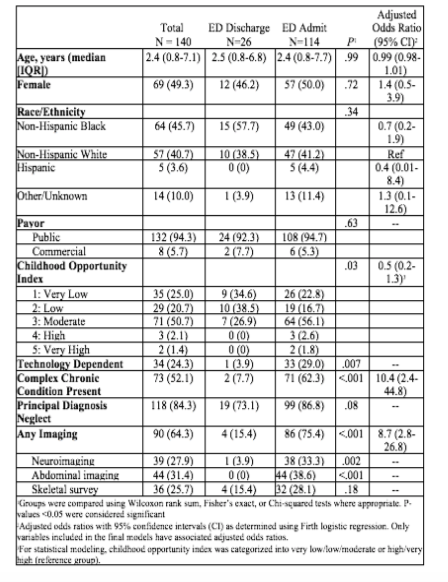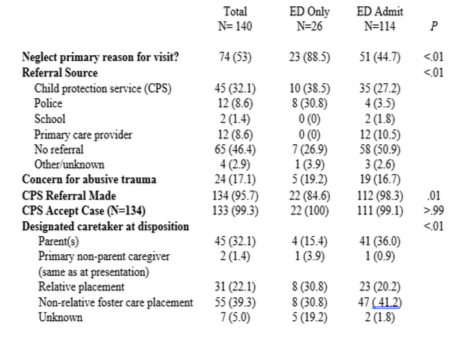Child Abuse & Neglect 1
Session: Child Abuse & Neglect 1
341 - Children with neglect evaluated in the emergency department and factors associated with hospitalization
Sunday, April 27, 2025
8:30am - 10:45am HST
Publication Number: 341.4062
Monica Singh, University of South Florida, Tampa, FL, United States; John Morrison, Johns Hopkins All Children's Hospital, Saint Petersburg, FL, United States; Kristen Calhoun, UT Southwestern, Dallas, TX, United States

Monica Singh, DO (she/her/hers)
Resident physician
University of South Florida
Tampa, Florida, United States
Presenting Author(s)
Background: Many children with suspected neglect, or concern that a child’s caretaker has failed to provide for a child’s needs such that their health or safety is at risk of harm, are evaluated in emergency departments (ED) for medical and non-medical reasons. While a significant body of literature has examined abusive maltreatment evaluations, there is a paucity of data regarding what groups of patients with neglect are evaluated in the ED and which factors are associated with the decision to hospitalize this vulnerable population.
Objective: To describe the population of children evaluated in the Johns Hopkins All Children’s Hospital (JHACH) ED with a diagnosis of neglect and identify demographic and clinical factors associated with hospitalization.
Design/Methods: We conducted a single site retrospective cohort study of children 0 to 17 years old with a principal or secondary ICD-10 code diagnosis of neglect who were evaluated in the JHACH ED between 1/1/2017 and 7/1/2022. Demographic, clinical, and disposition data were extracted from the Pediatric Health Information System (PHIS) database. Additional data was manually extracted from the JHACH electronic medical record. Children discharged from the ED were compared to children hospitalized with neglect using Chi-squared tests.
Results: The study included 140 eligible encounters; 26 (19%) children were discharged from the ED and 114 (81%) were hospitalized. Demographic and clinical characteristics are described in Table 1. The median age was 2.4 years, and most patients had public insurance (94%). The most common referral source was CPS followed by police and primary care providers, but many children were not directly referred to the ED. Children hospitalized with neglect had greater numbers of chronic complex conditions (CCC) and received imaging commonly used to assess for abusive trauma. In multivariable modeling, patients with ≥1 CCC (adjusted OR 10.4 (95% CI 2.4-44.8) and receipt of imaging studies (aOR 8.7 (95% CI 2.8-26.8) were independently associated with hospitalization.
Conclusion(s): This study suggests that children evaluated in the ED with neglect are often referred by CPS. In addition, these data suggest many children evaluated in the ED for suspected or confirmed neglect are not discharged back to their initial caregiver regardless of hospitalization. Our findings also demonstrate that children hospitalized with neglect at our institution are more likely to have CCCs, which could be because they require additional medical attention or due to difficulty finding appropriately trained caregivers prior to discharge.
Demographic and clinical characteristics of patients evaluated in the emergency department with a diagnosis of neglect

Child protective services and disposition details of patients evaluated in the emergency department with a diagnosis of neglect

Demographic and clinical characteristics of patients evaluated in the emergency department with a diagnosis of neglect

Child protective services and disposition details of patients evaluated in the emergency department with a diagnosis of neglect


